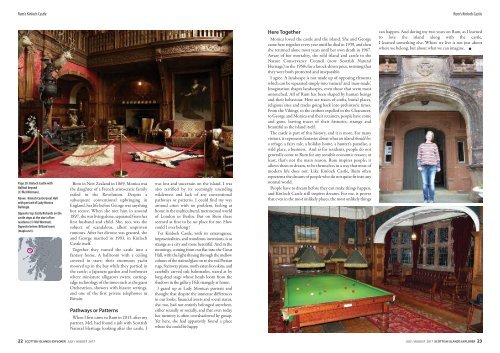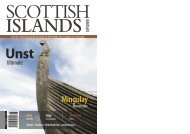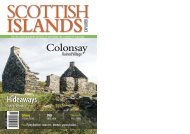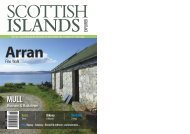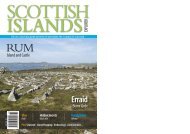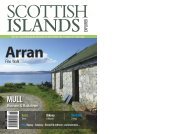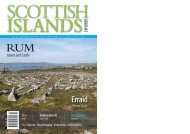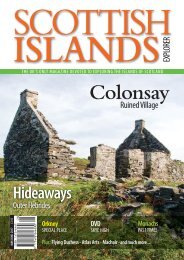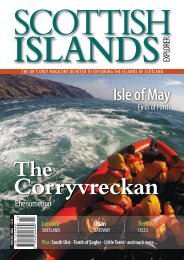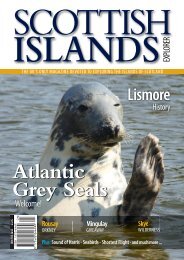Create successful ePaper yourself
Turn your PDF publications into a flip-book with our unique Google optimized e-Paper software.
Rum’s Kinloch Castle<br />
Rum’s Kinloch Castle<br />
Page 20: Kinloch Castle with<br />
Hallival beyond<br />
(© Mel Worman).<br />
Above: Kinloch Castle Great Hall<br />
with portrait of Lady Monica<br />
Bullough.<br />
Opposite top: Emily Richards on the<br />
castle steps at the start of her<br />
residence (© Mel Worman).<br />
Opposite below: Billiard room<br />
(mapio.net).<br />
Born in New Zealand in 1869, Monica was<br />
the daughter of a French aristocratic family<br />
exiled in the Revolution. Despite a<br />
subsequent conventional upbringing in<br />
England, her life before George was anything<br />
but secure. When she met him in around<br />
1897, she was living alone, separated from her<br />
first husband and child. She, too, was the<br />
subject of scandalous, albeit unproven<br />
rumours. After her divorce was granted, she<br />
and George married in 1903, in Kinloch<br />
Castle itself.<br />
Together they turned the castle into a<br />
fantasy home. A ballroom with a ceiling<br />
covered in stars; their enormous yacht<br />
moored up in the bay while they partied in<br />
the castle; a Japanese garden and hothouses<br />
where miniature alligators swam; cuttingedge<br />
technology of the times such as the giant<br />
Orchestrion, showers with bizarre settings,<br />
and one of the first private telephones in<br />
Britain.<br />
Pathways or Patterns<br />
When I first came to Rum in 2013, after my<br />
partner, Mel, had found a job with <strong>Scottish</strong><br />
Natural Heritage looking after the castle, I<br />
was lost and uncertain on the island. I was<br />
also terrified by its seemingly unending<br />
wilderness and lack of any conventional<br />
pathways or patterns. I could find my way<br />
around cities with no problem, feeling at<br />
home in the multicultural, metrosexual world<br />
of London or Berlin. But on Rum there<br />
seemed at first to be no place for me. How<br />
could I ever belong?<br />
Yet Kinloch Castle, with its extravagance,<br />
impracticalities, and wondrous inventions, is as<br />
strange as a city and more beautiful. And in the<br />
mornings, coming from our flat into the Great<br />
Hall, with the light shining through the mellow<br />
colours of the stained glass on to the red Persian<br />
rugs, Steinway piano, moth-eaten lion skins, and<br />
carefully carved oak balustrades, stared at by<br />
long-dead stags whose heads loom from the<br />
shadows in the gallery, I felt strangely at home.<br />
I gazed up at Lady Monica’s portrait and<br />
thought that despite the immense differences<br />
in our looks, financial assets and social status,<br />
she, too, had not entirely belonged anywhere,<br />
either sexually or socially, and that even today<br />
her memory is often overshadowed by gossip.<br />
Yet here, she had apparently found a place<br />
where she could be happy.<br />
Here Together<br />
Monica loved the castle and the island. She and George<br />
came here together every year until he died in 1939, and then<br />
she returned alone most years until her own death in 1967.<br />
Aware of her mortality, she sold island and castle to the<br />
Nature Conservancy Council (now <strong>Scottish</strong> Natural<br />
Heritage) in the 1950s for a knock-down price, insisting that<br />
they were both protected and inseparable.<br />
I agree. A landscape is not made up of opposing elements<br />
which can be separated simply into ‘natural’ and ‘man-made’.<br />
Imagination shapes landscapes, even those that seem most<br />
untouched. All of Rum has been shaped by human beings<br />
and their behaviour. Here are traces of crofts, burial places,<br />
religious sites and tracks going back into prehistoric times.<br />
From the Vikings, to the crofters expelled in the Clearances,<br />
to George and Monica and their retainers, people have come<br />
and gone, leaving traces of their histories, strange and<br />
beautiful as the island itself.<br />
The castle is part of this history, and it is more. For many<br />
visitors, it represents fantasies about what an island should be:<br />
a refuge, a fairy tale, a holiday home, a hunter’s paradise, a<br />
wild place, a business. And as for residents, people do not<br />
generally come to Rum for any sensible economic reason; at<br />
least, that's not the main reason. Rum inspires people; it<br />
allows them to dream, to be themselves in a way that most of<br />
modern life does not. Like Kinloch Castle, Rum often<br />
represents the dreams of people who do not quite fit into any<br />
normal world.<br />
People have to dream before they can make things happen,<br />
and Kinloch Castle still inspires dreams. For me, it proves<br />
that even in the most unlikely places, the most unlikely things<br />
can happen. And during my two years on Rum, as I learned<br />
to love the island along with the castle,<br />
I learned something else. Where we live is not just about<br />
where we belong, but about what we can imagine.<br />
22 SCOTTISH ISLANDS EXPLORER JULY / AUGUST <strong>2017</strong><br />
JULY / AUGUST <strong>2017</strong> SCOTTISH ISLANDS EXPLORER 23


